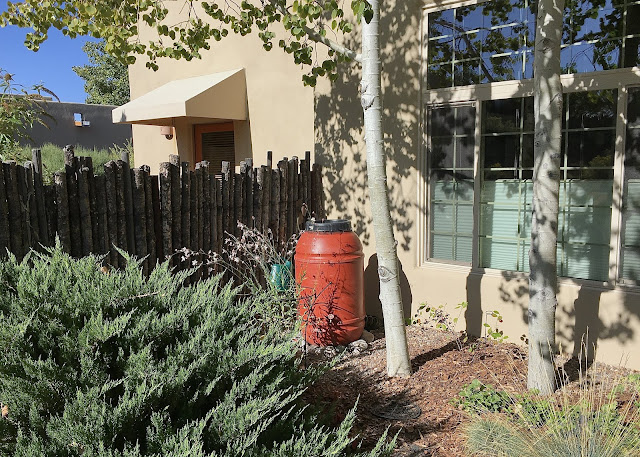The Rain Barrel
It seems obvious for water conservation in a dry climate -- get a rain barrel. Capture the water coming off the roof to store it and use it in the gardens. Much better than using city water to irrigate.
So I got a standard design 65 gallon plastic rain barrel, christened it Big Red, and put it right under a canale spout in front of our dining room window where it could be admired from inside.
But it wasn't at all the solution to saving and using water that I envisioned. Here's what I discovered:
First, the spigot near the bottom can take a hose attached to it, but of course the hose has no pressure, so without snaking complex soaker hoses throughout the gardens, it doesn't do much but empty water to one spot. Or I can hold the hose and hand water by dribbling it about, but it only reaches one garden.
So . . . I empty it from the top, scooping it up with a watering can, making multiple trips to various gardens to empty 60 gallons with a 2.5 gallon can, which is tedious.
Second, the spigot on all the models is well above the bottom of the barrel for some reason, so you can't drain the final foot of water. And my arms are too short to reach the watering can in all the way to the bottom to empty it.
So . . . water stands in it all the time at the bottom.
Third, it would be nice if it rained with a week between each rain event, so I could empty it in between. But we often get back to back thunderstorms in the summer and once the barrel is already filled, the next storm just overflows all around it, capturing nothing.
So . . . Big Red has to be emptied right after a storm, when the ground is already nice and soaked.
And fourth, the opposite happens too. We get no rain for months on end once summer monsoons are over. For eleven months when we first moved here there was no rain. A rain barrel does nothing for water conservation if there is no water in it.
So . . . It only works during the wet season, when the ground is already being irrigated by storm water.
A rain barrel is one of those concepts that seems intuitively efficient. But it doesn't actually work that well unless your rain comes in consistent installments a few weeks apart, all year long, and in reasonable quantities that won't overwhelm its capacity.
In other words, if you live in the east.



Comments